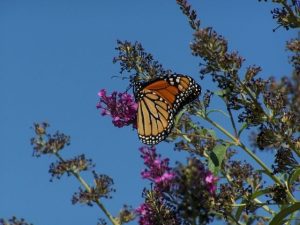Recently, in a fit of joy at seeing a Monarch butterfly exploring the milkweed flowers in my back yard, I texted a friend who had shared a winter trip to a Monterey Coast Monarch sanctuary. She and I then had a long, follow-up telephone conversation about “sense of place.”
We each moved from the standardized, hodge-podge “design” of suburban lawns and gardens to a mixed conifer forest or a coast redwood forest. I have since moved again from the evergreens at 4000-foot-elevation to the oak savannah of Jamestown. In our phone conversation, we marveled at the deep appreciation each of us has gained for the sense of place in our adopted environments.
Many of us bring this generic, blank-slate mindset with us when we move from elsewhere. One dear friend moved to the rolling, blond hills of Fairfield and immediately started transforming her backyard, planting both coast redwood and giant Sequoia next to each other. She looked at the “empty” space only from a design perspective, not realizing that those two trees do not grow in the same environments, and neither grows naturally in the arid windiness of Fairfield.
Recognizing the sense of a place, noting what makes an area unique – whether it be desert, foothill, mountain, ocean coast or redwood forest – inspires an emotional reaction. First comes a sense of recognition. This is not a blank slate. Each environment is a tapestry of plant, soil and climatic interactions. Then, often, comes a sense of protectiveness. People become passionate about “saving” the native plants that support native animals. Examples are foundations dedicated to saving the redwoods or saving the monarch butterfly (I don’t know of any foundations dedicated to saving the suburban landscape!)
One Master Gardener friend tells a story of moving here from a lush, sub-tropical southeastern state and deciding that she would transform her dry, oak-and-gray-pine property into a tropical paradise. Such an undertaking would not only create unhealthy and unhappy plants that would struggle to survive in our Mediterranean, no-rain-in-the-summer climate, but would use acre-feet of water, a precious commodity in drought-y, desert-y California.
It was her experience in learning to recognize a new sense of place that inspired an effort to help “transplants” to the Sierra foothills. Garden techniques learned in other areas may not work here. So, to help ensure garden success in the Sierra foothills, University of California Cooperative Extension (UCCE) Master Gardeners of Tuolumne County developed a list of principles for “Foothill-Friendly Gardening.”
During the month of August, we will dedicate the articles in this column to the following principles:
1. Be Fire Safe
2. Right Plant – Right Place
3. Water Efficiently and Effectively
4. Feed the Soil
5. Recycle
6. Garden for Wildlife
7. Manage Pests Responsibly
8. Preserve Our Native Oaks
In this year of extreme tree mortality, we do not mean to overlook the plight of conifers stressed from years of drought and bark beetle attack. For more information, please go to http://cecentralsierra.ucanr.edu/ On the front page is bark beetle information, what to do with dead and dying trees, and the California Forest Stewardship Helpline. In light of the tree mortality situation, we will talk next about fire safety and fire safe landscaping.
Rebecca Miller-Cripps is a UCCE Master Gardener in Tuolumne County; she retired from the UCCE Agriculture and Natural Resources Program.



